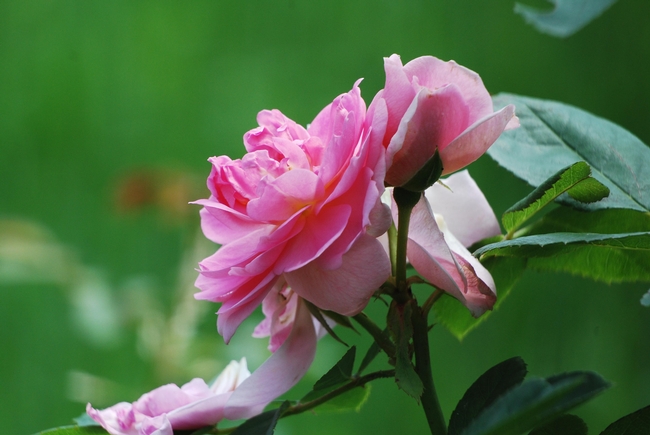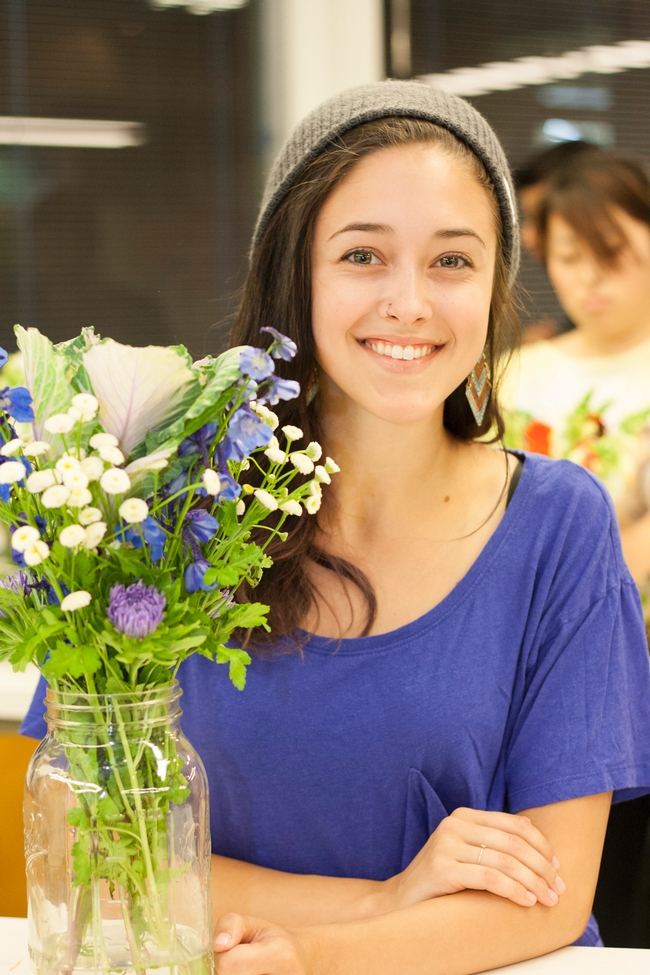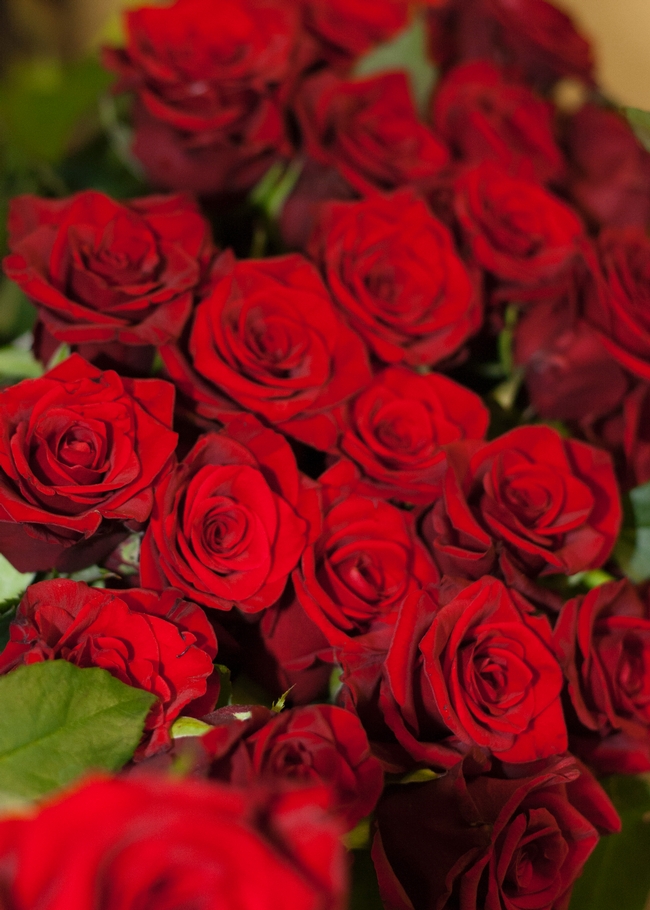Posts Tagged: flowers
Real Reason for Flowers? It's All About Sex
You could say that noted entomologist/author Stephen Buchmann has a thing for buds, bees, beetles and butterflies...buds that burst into flowers, and...
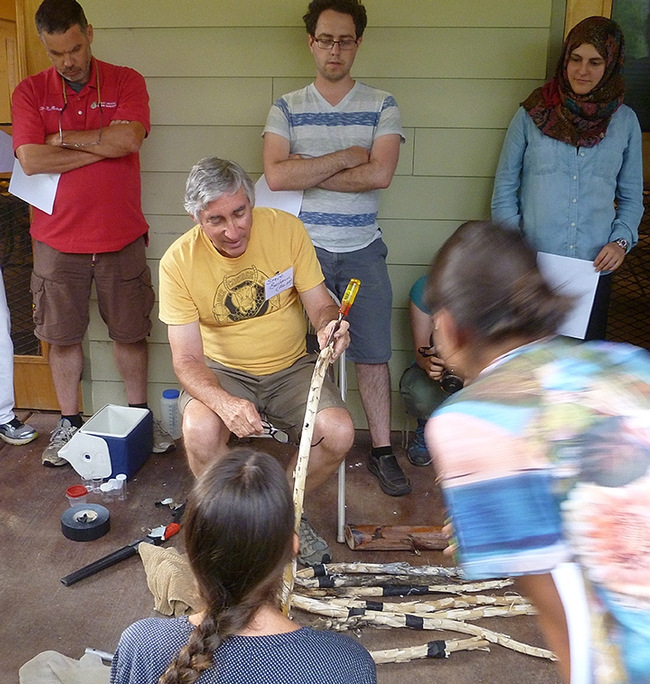
Entomologist Stephen Buchmann talks about the nests of carpenter bees at The Bee Course, an annual summer workshop in Arizona sponsored by the American Museum of Natural History. (Photo courtesy of Robbin Thorp)
“Greening” up your Valentine’s Day gift
Valentine's Day is one of the most demanding holidays in the cut-flower industry. Consumers struck by Cupid's arrow spend more than $1.9 billion on cut flowers alone. To prepare for the enormous demand for roses, growers produce an estimated 233 million roses, according to an About Flowers research study.
California Growers Making Changes
While many consumers are thinking about love – few are thinking about the impact the cut-flower industry is making on the environment. Since 1990, California has required the agricultural industry to report on all pesticide use, this includes detailed pesticide reporting for the cut flower industry.
Research shows pesticide use in California cut-flower production declined by almost 50 percent from 2001 to 2010. According to a recent UC Division of Agriculture and Natural Resources (UC ANR) article, there are many reasons for the reduction including increased rules and regulations, early pest infestations practices, a new generation of organic growers and increased public awareness.
California cut-flower farmers have vastly improved their pesticide use and policies over the past decade. The state currently produces 60 percent of roses sold in the U.S. each year, but growers simply can't keep up with the Valentine's Day surge in demand during the cold winter months when production slows. These factors contribute to a vast majority of the roses sold in February being imported from Columbia and Ecuador.
Impact of Imported
In a typical year, between 85 percent and 95 percent of the most common fresh cut flowers sold in the U.S. are imported from Colombia or Ecuador, according to an article in One Green Planet. With fewer restrictions on pesticides in South America, the environmental impact of growing roses in these countries can be devastating.
“To cultivate that perfect rose, growers often resort to chemical weed and insect killers,” Alejandro Boada of Universidad Externado de Colombia states in an article in Organic Bouquet. “Pesticides have been found 300 to 400 meters deep in the soils, which have been unable to filter these poisons. Meanwhile, demand for water has also been found to strain local aquifers, on which other farms depend.”
Not only does aggressive pesticide use in these countries have a destructive environmental impact, their fragile imported roses often have to fly thousands of miles to wholesale warehouses and transported in energy-guzzling refrigerated trucks before reaching the flower shop cooler.
Alternatives for Your Valentine
Don't worry, there are plenty of romantic alternatives with a smaller carbon footprint for your Valentine this year!
- Give a native plant. Native plants thrive in your local environment and provide food for pollinators like bees and butterflies.
- Find a local flower grower in your town using The Association of Specialty Cut Flower Growers online U.S. database. Not only are you supporting a small often-times family-based farm, you are investing money back into your local economy.
- Connect with fresh, beautiful, organically raised flowers using an online database from Local Harvest.
- For a food-lover, potted herbs make a great gift.
- Gardeners love collections of seed packets for a bountiful summer harvest garden.
Learn about growing roses for your Valentine in your own garden by joining the UC Master Garden Program in your area.
Re-purposing a Tree Stump
If you read my July post on stunting sunflowers, you know I tend not to follow convention. But as I said then, the joy of gardening is in the hands of the individual. So this post on re-purposing a tree stump should not surprise you.
My driveway used to be lined with 50 plus year old Monterrey pine trees. But the past few years I’ve had to have several of them removed because they’ve been killed by tree borers. For the most recent pine tree I had cut down, I decided not to have the tree service remove the stump for budget reasons. Instead I had them just cut the stump down to about waist high. My idea at the time was to use the stump as a huge plant stand for one of my enormous planters. That idea quickly fell apart because my huge planter was just too heavy for me to lift onto the tree stump.
So I thought why not just plant something directly on top of the stump. To keep the soil confined to the top of the stump, I purchased some cheap plastic lawn edging, cut it the size of the stump, and fastened it together into a circle. I laid it on top of the stump and filled it with potting soil. I planted succulents around the edges, but I wanted a deeper soil depth to plant some marigolds. So I cut and fastened a smaller circle of lawn edging and centered it on top of the already poured potting soil. I filled the smaller circle with soil and planted the flowers. And since I had another potted flower plant I haven’t decided where to plant yet, I plopped it into the center of the second circle for the time being. So in the interim until I get around to having the stump removed, I have an additional planting area for annual flowers.
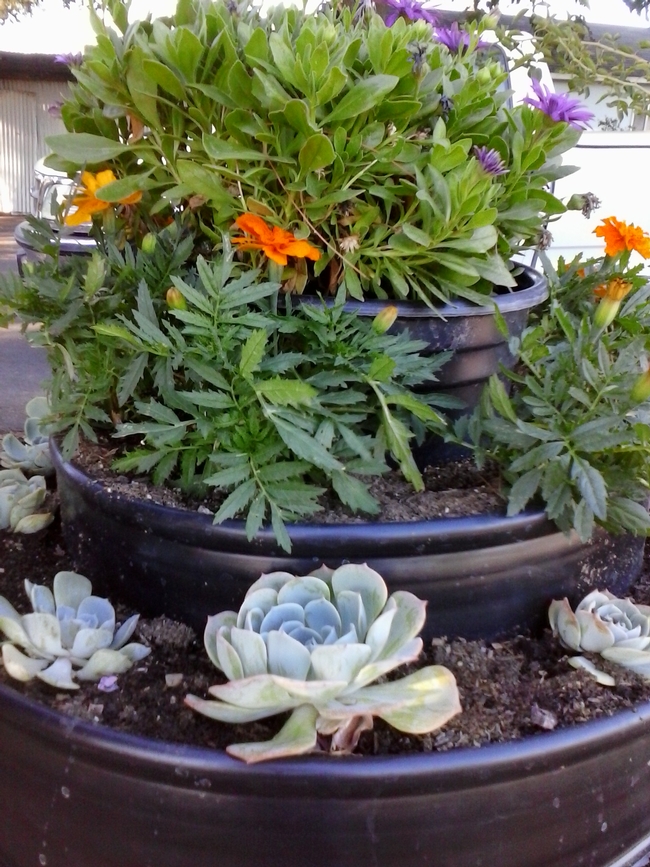
Colorful planter. (photos by Kathy Low)
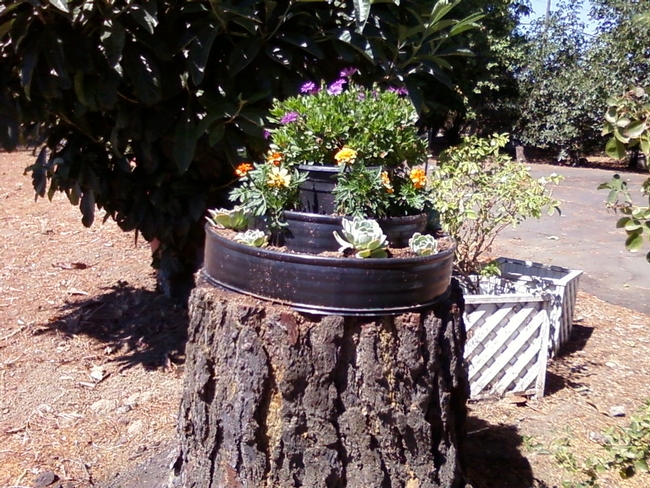
The whole view.
The art and science of Heiner's Flower Power
At the front of the class students pluck choice flowers from a line of buckets. They trim the stems and clip the leaves, bunch a few together, arrange and rearrange them. Anthony Neve, biting his lip, places the last snapdragon in his bouquet. A graduating senior, Neve found his way into the Environmental Horticulture and Urban Forestry major and into this class as a result of his family business, Neve Brothers Wholesale Cut Flowers, which he hopes to help continue after college.
“It’s everything I’m interested in,” he admits, maintaining his focus on the ebullient bouquet before him. He lowers his head and cranes his neck, studying the arrangement from several angles. “Every day’s something new to learn.”
The course is PLS6. But the students often hear about it from its title, “Flower Power.” Professor Heiner Lieth, UC Cooperative Extension specialist in the Department of Plant Sciences at UC Davis, bills Flower Power as a fun, easy way to introduce students to a broad swath of floriculture, an industry last year worth $4 billion in U.S. sales alone, with California leading the states.
Many students, like Brinton Parker, a junior English major minoring in textiles and clothing, are drawn to the class mainly by their own curiosity. “I wanted to learn more about flowers and to satisfy my science requirement,” she says, having perfected her flower arrangement, adding: “And I kill everything I touch.”
The class begins with flower biology and societal impacts, then leads into flower colors and bouquet compatibility and delves into cut flower lifespans, transportation issues, disease management and many other topics. Lieth forces the students to rethink GMOs, he says. He shows them how the world of flowers is completely dependent on genetics and he asks them if blemishes in organic flowers are actually important to the untrained eye. The idea is to switch up the routine and always “throw something at the students they cannot possibly expect.”
Today they are working on the art of flower arrangement. It’s a special workshop the teaching staff has put together with donated flowers from industry partners. The students are applying lessons on how to strategically assemble a bouquet that graduate teaching assistant Grace Lin demonstrated at the start of the class.
“It begins well be fore the class starts, with growing the flowers and getting the timing right,” says fellow TA Pete Cohen, explaining how some of the flowering plants used in the course were grown by him and interns in a campus greenhouse beginning months earlier. “Timing the flowers to bloom is a challenge. But in the department you learn all that.”
For Heiner Lieth, Flower Power is a teaching experiment that began three years ago. Inspired by Professor Dave Burger’s easy-going relationship with his students, Lieth wanted to provide an experience that catered towards what exactly his students wanted from a class. And to break old habits of lecture-style teaching, Lieth approached his new class as if he were offering the students a money-back guarantee. He calls it client-based teaching.
“They want a general purpose, nice and easy course, two units, general ed., science, writing, math,” undergraduate adviser Theresa Costa told Lieth when he was exploring ideas for the class. “They want it to fill their calendars.”
He came up with an introductory-level course and a title that would on its own seduce students into joining the course: “Flower Power: the Art and Science of the Beauty and Perfection of Flowers.” Quickly word-of-mouth spread and now, in the most recent quarter, the class was full within 48 hours. And, once he raised the cutoff to 190 students, it immediately filled again. “It’s extremely magnetic for students,” Lieth says.
The course is easy, he says, only in the sense that students will pass if they show up and do the work – though the workload is enough to keep them busy the entire term. And when this class finishes their flower arrangement workshop, they take their bouquets home, along with an intimate knowledge of an industry that few on campus have had the opportunity to sample.
See more Flower Power photos at the Department of Plant Sciences Facebook page here.
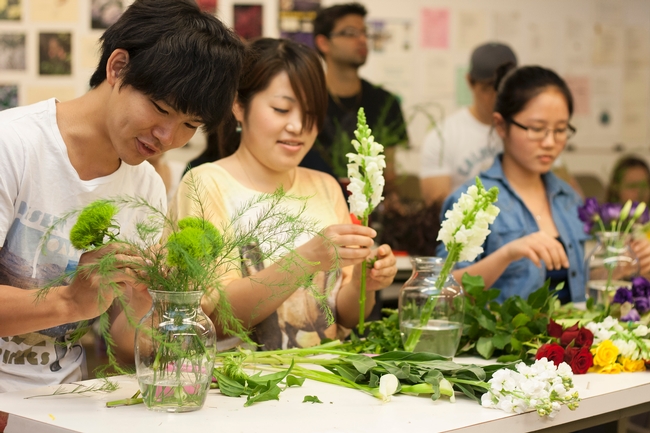
“It’s extremely magnetic for students,” Heiner Lieth says about Flower Power.
Butterflies and Blooms
I enjoy the ever-changing special exhibits at the Conservatory of Flowers in San Francisco, because I find the displays to be both well-designed and thoughtfully researched.
My most recent visit to the Conservatory was no different. The current exhibit on display is captioned “Butterflies & Blooms.” Although I had read the exhibit’s promotional materials about how visitors can experience the butterflies up-close, I was not sure what to expect. Upon entering the exhibit hall, I was delighted to see all manners of butterflies (approximately 13 different varieties, including, but not limited to, the Eastern Tiger Swallowtail, Monarch, Julia, Zebra Longwing, Small Postman, Common Buckeye, Viceroy, Spicebush Swallowtail, Giant Cloudless Sulphur, Cabbage White, and Red Admiral) fluttering about in the exhibit hall, which was decked out with spectacular blooms and filled with riotous color. Amazingly, these butterflies ignored the throngs of people and went about their business, pollinating flowers. Indeed, it was not unusual for several butterflies to congregate on a single sunflower as on-lookers stared on (see pictures below). I was able to get so up close to a number of butterflies, that I could even observe them using their proboscis (tongue) to reach the nectar located deep within the flowers.
There was also a display of the various pupae belonging to the types of butterflies present in the exhibit hall. Most had the appearance of shriveled leaves so that wild predators would bypass them in nature and not eat them. The exception was the pupa of the monarch butterfly, which had the appearance of a translucent jade pendant, inlaid with gold flecks (apologies that the picture below did not come out clearly).
Don’t miss out on this wonderful opportunity to observe and learn more about these amazing pollinators. This current exhibit will be on display until October 20, 2013. For more information, please see http://www.conservatoryofflowers.org/special-exhibits.
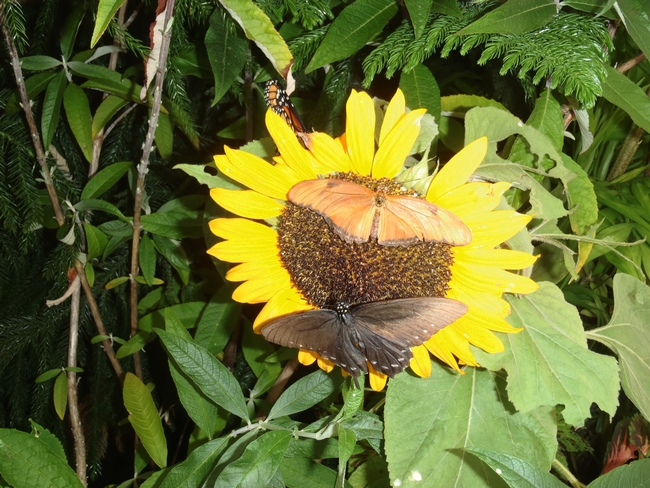
photos by Betty Homer
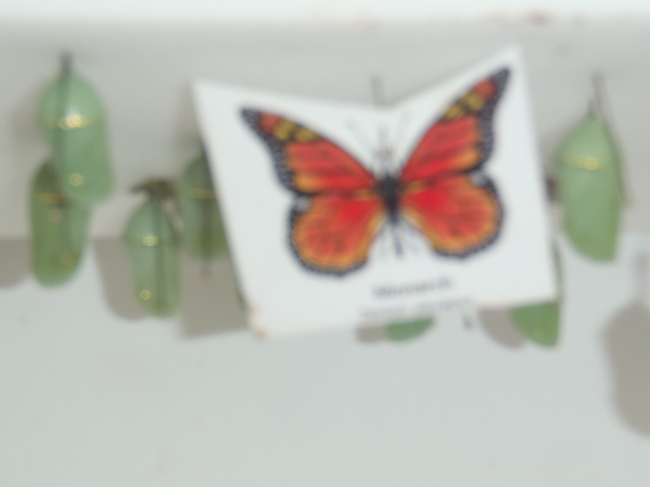
P7201747
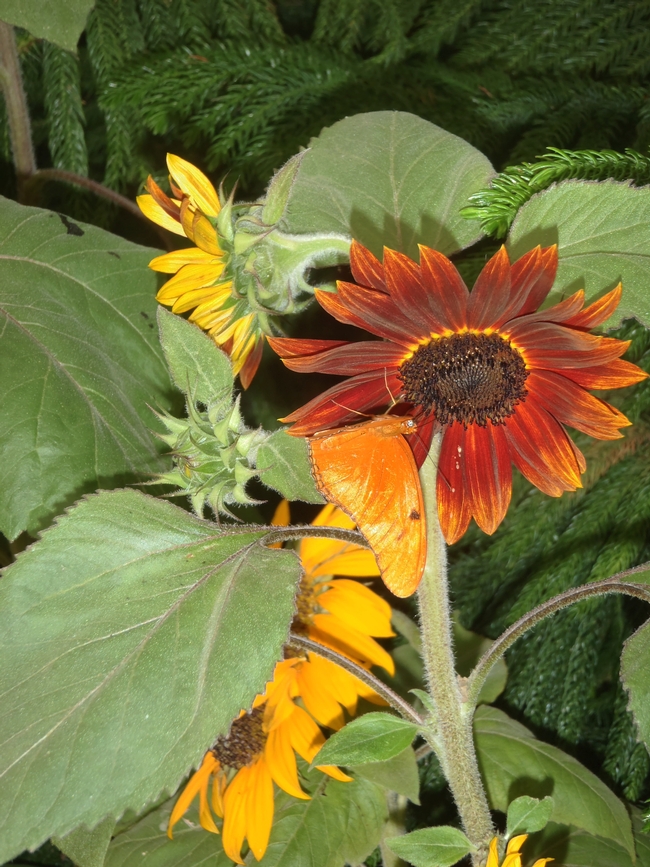
P7201750
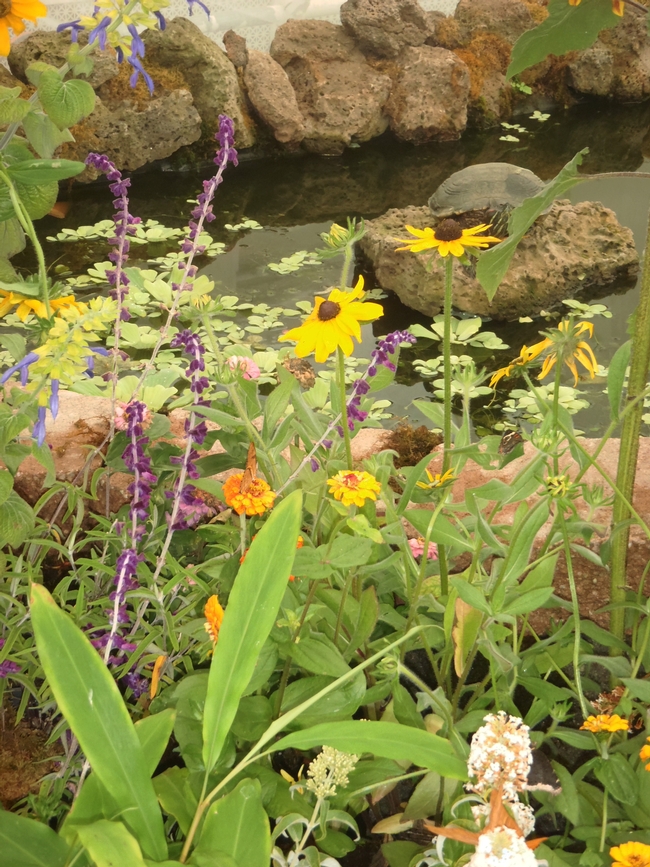
P7201751


